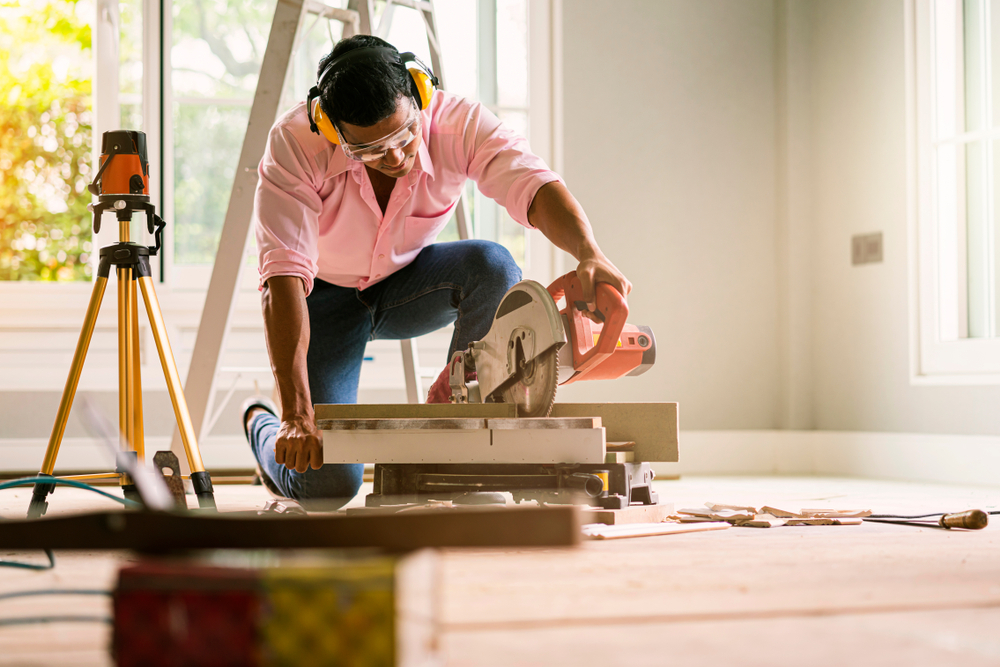One of the biggest hurdles when planning home renovations for the year can be figuring out how to pay for them. Many factors go into deciding which projects to undertake, but the budget is probably the biggest outside of logistics. It’s important to have a plan to avoid an unfinished remodel.
The Cost of Home Renovations
It depends on the project’s scope, but the costs for any home renovation can vary widely. Whole-home or room remodels range from $5,000 to $10,000 for a living room or $5,000 to $40,000 for kitchens. Minor refreshes or home improvements, like new appliances, can also be expensive, costing from $200 to $10,000, depending on the brand and features you want.
Other factors that can affect the cost of your home improvement project are whether or not you need to pull building permits, the age of your home, the type of materials used, and whether you DIY or hire a professional. Additionally, you might uncover hidden issues that you need to address, such as mold or wood rot. These can make your total costs balloon and leave you figuring out how to get the extra funds you need.
Ways to Finance Your Home Renovations
You have many options when it comes to paying for any home project you have your eye on. Understanding how these options will affect your finances is important. In some cases, you’ll have to factor in how accessing the funds will impact your ability to complete the project.
Cash or Savings
One of the best ways to finance your home projects is to use funds you already have. Paying in cash means you know exactly how much you have to spend on a renovation and you’re not incurring any debt. However, it can take a while to save up the amount of money you need, which can be a drawback. Additionally, if you’re using existing savings, you run the risk of not having an emergency fund if something happens.
This method can be a good way to finance minor home upgrades or redecorating one specific area.
Credit Cards
Using a credit card is a popular option for home improvement projects, especially for projects like small remodels or appliance upgrades. When using a credit card for larger purchases like this, it’s vital to consider the interest rates, which are typically higher with credit cards, and how long it will take you to pay the balance off.
While there are benefits like cash-back rewards and introductory rates, you’re beholden to the card’s credit limit, meaning you might not have enough money and either need to open another account or seek other financing. You’ll need a good enough score to get approved for a card, which might not be possible if you have a lower credit rating. Your score will also be impacted if your utilization is high or you miss payments.
Your Home’s Equity
There are a few different ways to use the equity in your home to finance a home renovation.
Home Equity Loans
A home equity loan is known as a second mortgage. It allows you to use the equity in your home to pay for any home improvements in a lump sum at a fixed interest rate that you pay back over time. It requires you to use your home as collateral, so there is a risk of foreclosure if you default on the loan or an underwater mortgage if your property value declines.
Home Equity Line of Credit (HELOC)
The difference between a home equity loan and HELOC is that HELOC acts as a revolving line of credit with a variable interest rate, meaning you can borrow more than once if needed as you repay the money. There’s a borrowing period of 10 years typically, during which you can access the funds and withdraw any amount up to the credit limit. The benefit is that you only pay interest on the money you use, not the total amount you can access. It also uses your home as collateral, so there’s still the risk of foreclosure.
Refinancing Your Home
If you don’t want to take on a second mortgage, you could also refinance your existing mortgage with a cash-out refinance. This would replace your existing loan with a larger one where you keep the difference between the new total and what you currently owe on your home. You can then use that money for any home projects. This might make sense for you if you’re planning a bigger renovation or remodel and planning to stay in your home for a long time.
Home Improvement Loans
If you don’t have enough equity to fund your project or don’t want to use your home as collateral, then an unsecured home improvement loan might make more sense. This is a personal loan you can use to fund your home improvements, though the terms of the loan don’t specify what you need to use the money for.
If approved for the loan, you can have your money in a matter of days, making it one of the quickest ways to get the funds you need. It’s also a good option for those with a less-than-stellar credit score since some lenders, like Balance Credit, offer home improvement loans for bad credit.
Top 10 Home Projects to Tackle This Year
Making improvements to your home is a good way to add value, improve its aesthetics, or make it more efficient. There is no shortage of home improvement projects, so considering your priorities will help you narrow down where to start.
Here is a list of the most popular home projects for 2025:
- Install high-efficiency windows
- Upgrade to more efficient appliances
- Change the floor plan
- Remodel your kitchen or bathroom
- Have an addition put on your home
- Put in new flooring
- Finish your basement
- Update the exterior of your home
- Renovate your backyard
- Install a deck or patio
How to Choose the Right Financing Option For You
Choosing how to finance the project is almost as important as choosing the project itself. Many factors must be considered to accomplish your home renovation dreams without compromising your finances.
The Cost and Scope
Understanding the scale of the project you want to tackle can help narrow down which option would work best. Having estimates done for how much the project will cost will also help you decide. For instance, you might not want to tap into your home’s equity for a smaller project or take on a loan if you can save up the money quickly.
The Amount of Time It’ll Take
Is this a project you must complete sooner due to seasonality, or maybe an emergency home repair? This might impact how quickly you need access to the funds you need. If you’re dealing with an emergency situation, you might be able to go through your home insurance. But that can take time, as can getting approved for any loan or line of credit you might need. Researching how long these processes take, plus how long it’ll take to complete your renovation, will help you build an accurate timeline.
Your Current Financial Situation
Knowing which financing options are available to you requires evaluating your current situation. Your current credit score and debt load can impact the kind of financing you’re approved for. If your credit rating is a concern, Balance Credit offers home renovation loans for bad credit, so you can have the home of your dreams even if your score is a little bit of a nightmare.
What Are Your Financial Goals?
If you’re currently trying to get out of debt or not incur any more, then you’ll likely choose to save up for your home improvements. If you want to pay off your home quickly, you probably won’t opt for a second mortgage. When taking on a loan or line of credit, you have to be able to cover the payments on the money you borrow, so it’s important to know how that fits into your financial goals. However, your home projects might be worth the cost if you’re trying to add value to your home or if they’ll allow you to stay in your home longer.
Balance Credit Can Help You Achieve Your Home Renovation Goals
Your home improvement goals shouldn’t be put on hold because you can’t get the necessary funds. Getting the home improvement financing you need is simple with our secure online portal. Balance Credit’s home repair loans are a good option for those who don’t own a home or don’t want to wait until they have the funds saved up.
They are also ideal for those with lesser credit ratings because a bad credit score doesn’t automatically disqualify you from being approved for our home improvement loans. See how much money you’re eligible for and start renovating your home in just a few days with a little help from Balance Credit.






